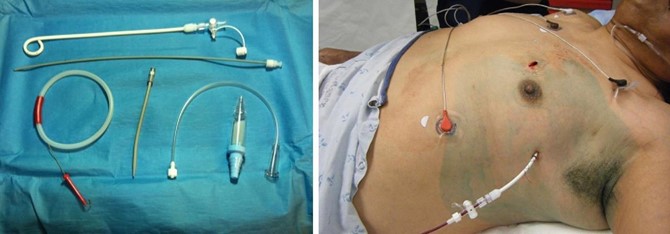Potential Complications and Interventions for Chest Tube Malfunction or Removal
- The potential complications and interventions for chest tube malfunction or removal are: Open in browser
|
Complication |
Description |
Intervention |
|
Infection |
A bacterial invasion of the pleural space or wound site that causes fever, chills, increased white blood cell count, purulent drainage, redness, swelling, or pain. |
Administer antibiotics as ordered. Monitor vital signs and wound site. Change dressing using sterile technique. Obtain cultures as ordered. |
|
Bleeding |
A hemorrhage from the chest tube insertion site or from the lung or pleural vessels that causes increased drainage (>100 mL/hour), bright red drainage, hypotension, tachycardia, pallor, or decreased hemoglobin. |
Apply pressure dressing to the wound site. Monitor vital signs and drainage. Notify the physician. Administer fluids and blood products as ordered. Prepare for surgery if needed. |
|
Air leak |
A leakage of air from the chest tube system that causes continuous bubbling in the water-seal chamber or a loss of tidaling. |
Locate the source of air leak by clamping the tubing at different segments (starting from the chest) until bubbling stops. If leak is in the tubing or drainage system, replace or repair it. If leak is in the chest tube or wound site, notify the physician. Apply occlusive dressing to seal wound site. |
|
Tension pneumothorax |
A life-threatening condition where air accumulates in the pleural space and causes increased intrathoracic pressure that compresses the lung and shifts the mediastinum to the opposite side. It causes severe dyspnea, hypoxia, hypotension, tachycardia, tracheal deviation, jugular venous distension, absent breath sounds on affected side. |
Release any clamps on the tubing. Assess for kinks or obstructions in the tubing. Notify the physician immediately. Prepare for needle decompression or chest tube insertion on affected side. Administer oxygen as ordered. Monitor vital signs and oxygen saturation. |
|
Subcutaneous emphysema |
A condition where air escapes into the subcutaneous tissue around the chest tube insertion site or wound site. It causes crepitus (crackling sensation) on palpation. |
Notify the physician. Monitor respiratory status and oxygen saturation. Administer oxygen as ordered. Elevate head of bed to facilitate breathing. |
|
Re-expansion pulmonary edema |
A rare but serious complication where fluid accumulates in the lung tissue after rapid re-expansion of a collapsed lung. It causes dyspnea, hypoxia, coughing up pink frothy sputum, crackles on auscultation. |
Notify the physician immediately. Administer oxygen as ordered. Monitor vital signs and oxygen saturation. Administer diuretics as ordered. Prepare for intubation or mechanical ventilation if needed. |
- The procedure for chest tube removal involves:
- Obtaining a physician’s order and informed consent from the patient
- Administering analgesia or sedation as ordered
- Preparing sterile supplies such as dressing, suture removal kit, petroleum gauze
- Positioning the patient in semi-Fowler’s position with affected arm raised above head
- Instructing the patient to perform Valsalva maneuver (exhale forcefully with mouth closed) or hold breath at end expiration
- Cutting sutures and removing chest tube quickly with one motion
- Applying occlusive dressing with petroleum gauze over wound site
- Instructing patient to resume normal breathing
- Obtaining a
- Obtaining a chest x-ray to confirm chest tube removal and absence of pneumothorax
- Monitoring and assessing the patient’s respiratory status, vital signs, pain level, wound site, and dressing for any signs of complications such as infection, bleeding, air leak, or pneumothorax
- Educating the patient and family about the wound care, activity restrictions, signs and symptoms to report, and follow-up care

Nursing Test Bank
Naxlex Comprehensive Predictor Exams
Questions on Potential Complications and Interventions for Chest Tube Malfunction or Removal
Correct Answer is C
Explanation
Correct Answer is ["B","D"]
Explanation
Correct Answer is B
Explanation
Correct Answer is A
Explanation
Correct Answer is B
Explanation
Correct Answer is D
Explanation
Correct Answer is E
Explanation
Correct Answer is D
Explanation
Search Here
Related Topics
More on Nursing
Free Nursing Study Materials
Access to all study guides and practice questions for nursing for free.
- Free Nursing Study Trials
- Free Nursing Video tutorials
- Free Nursing Practice Tests
- Free Exam and Study Modes
- Free Nursing Revision Quizlets
